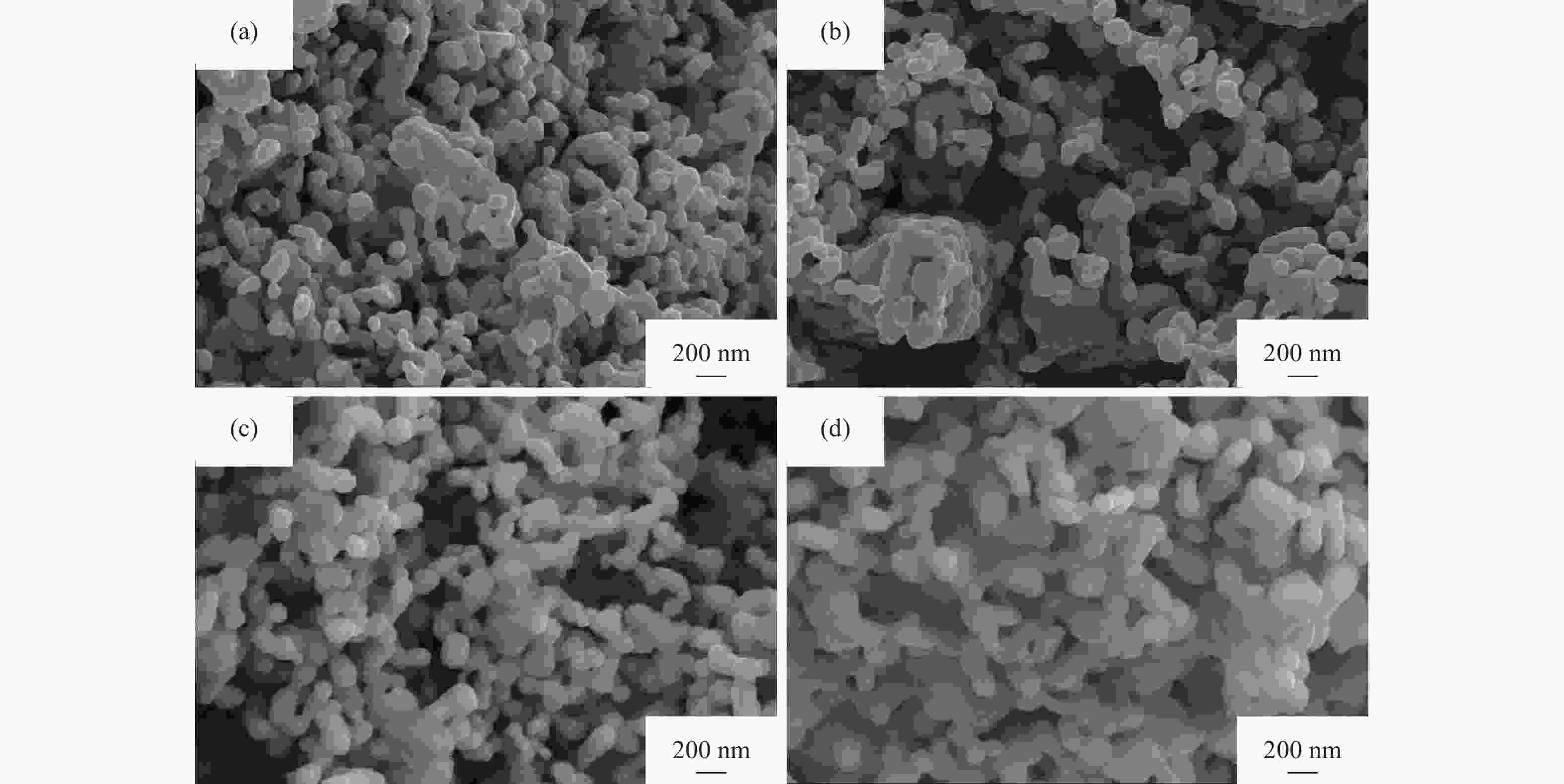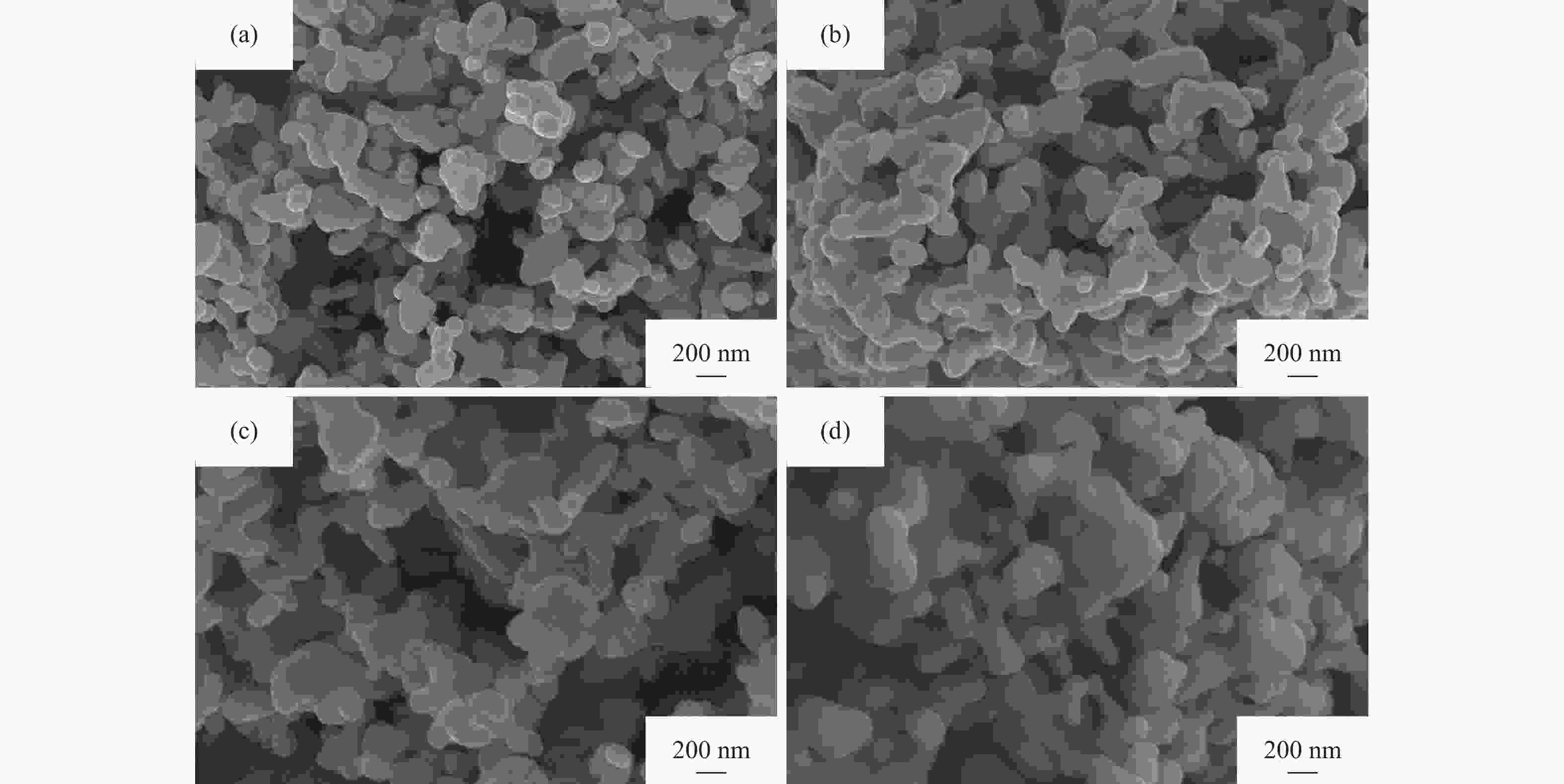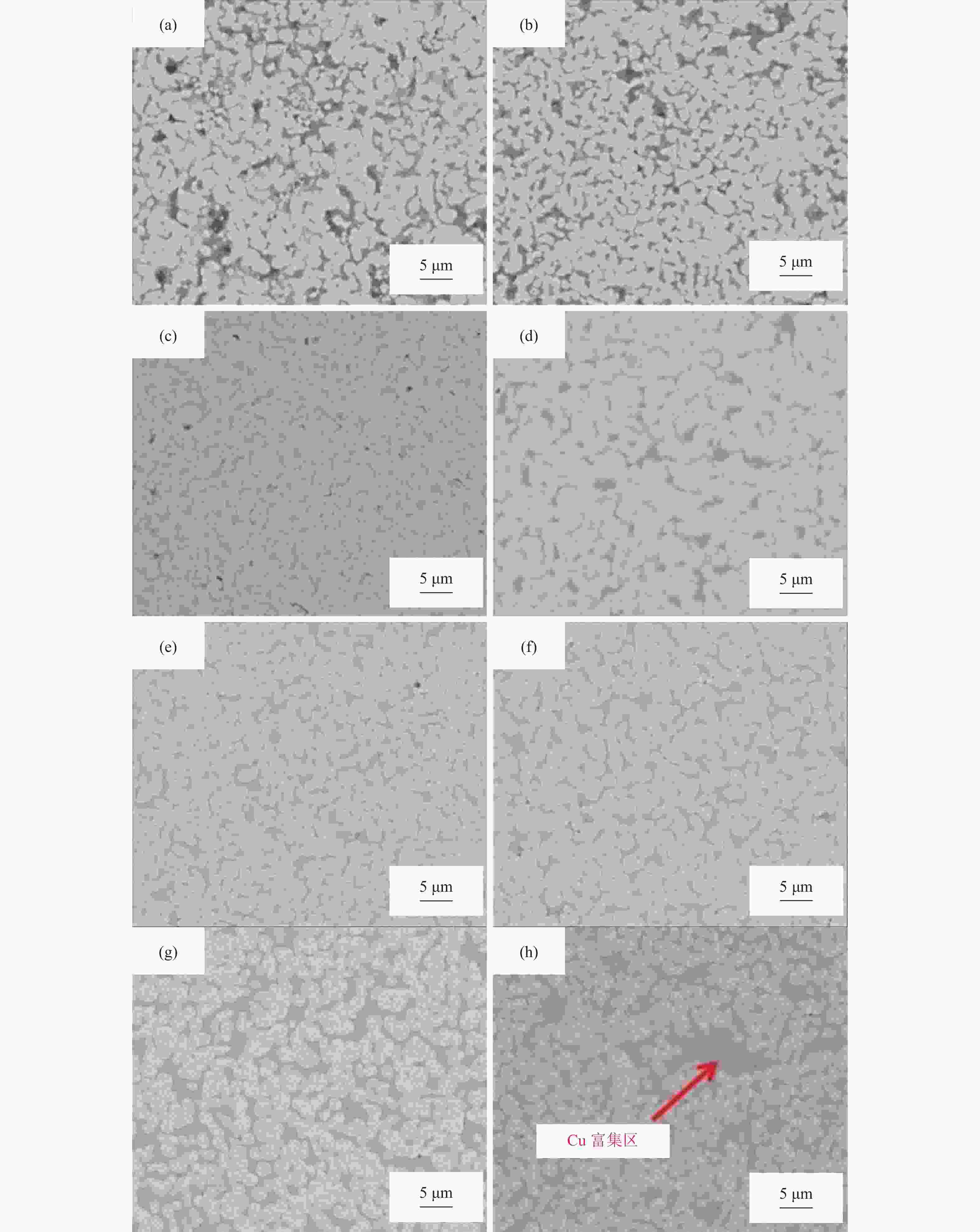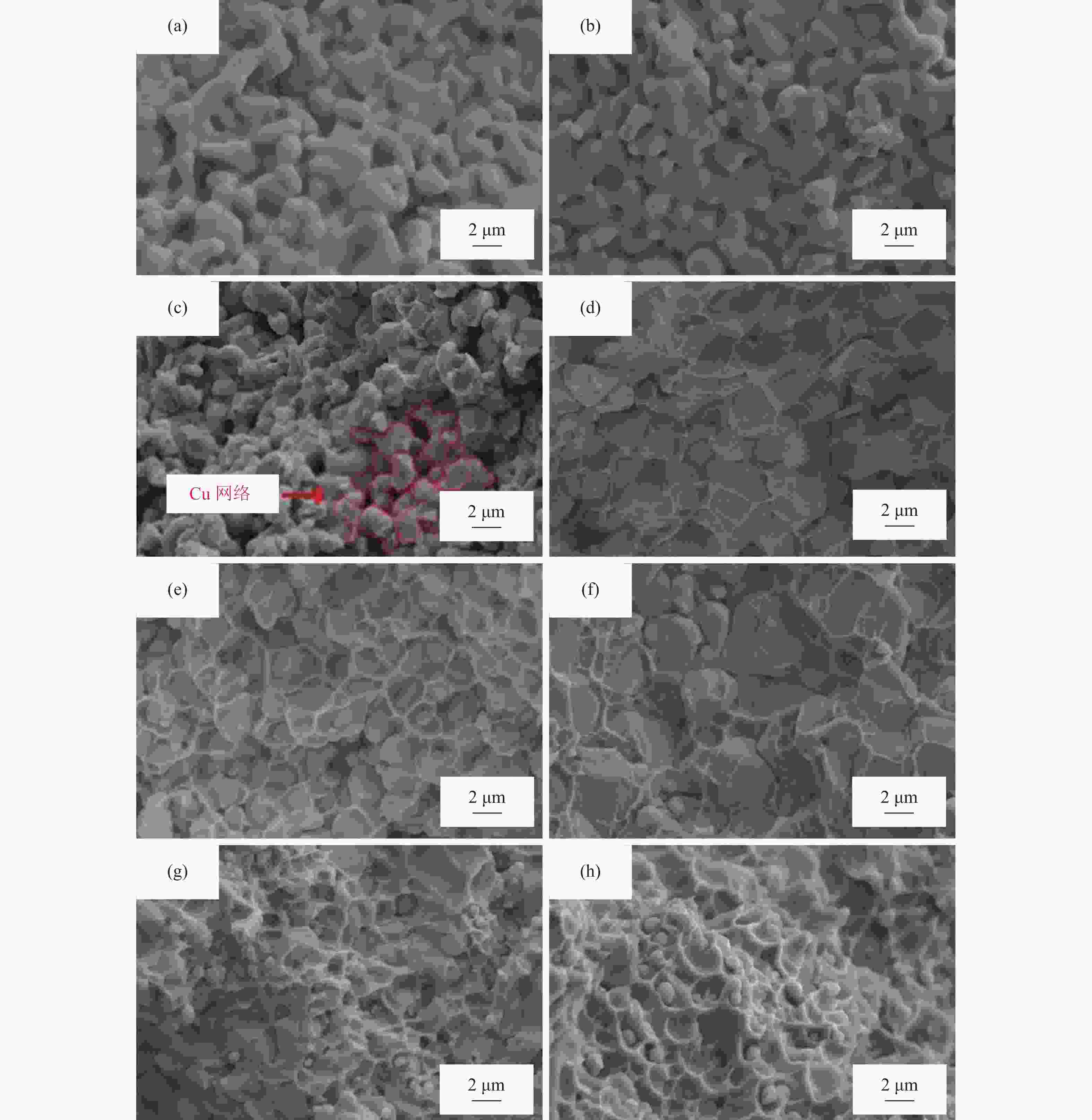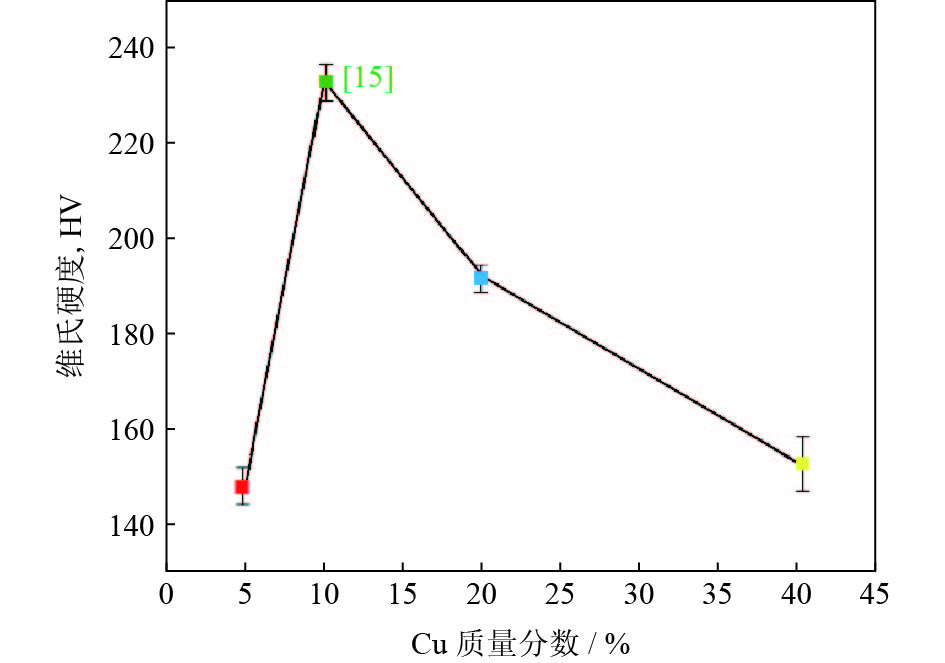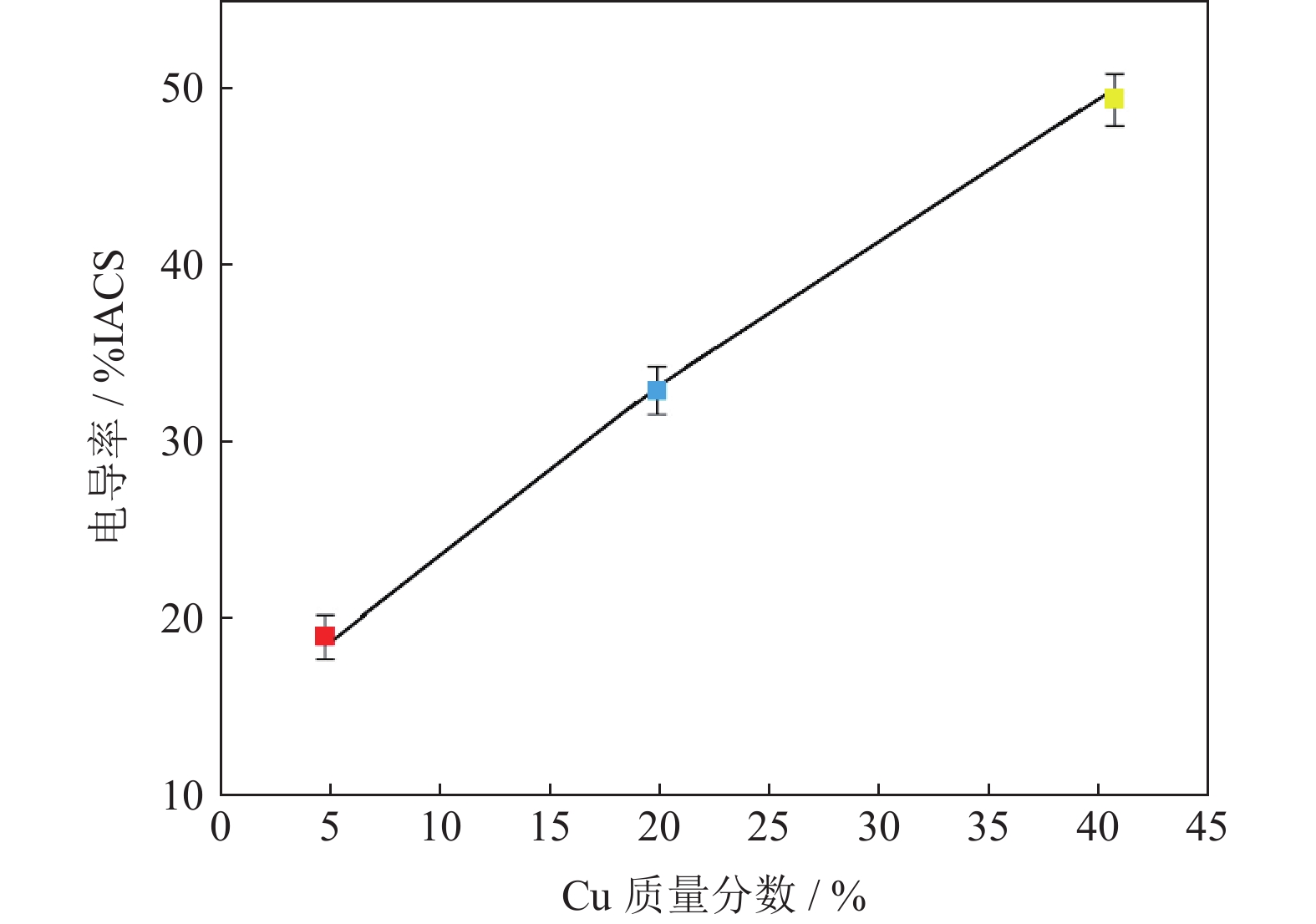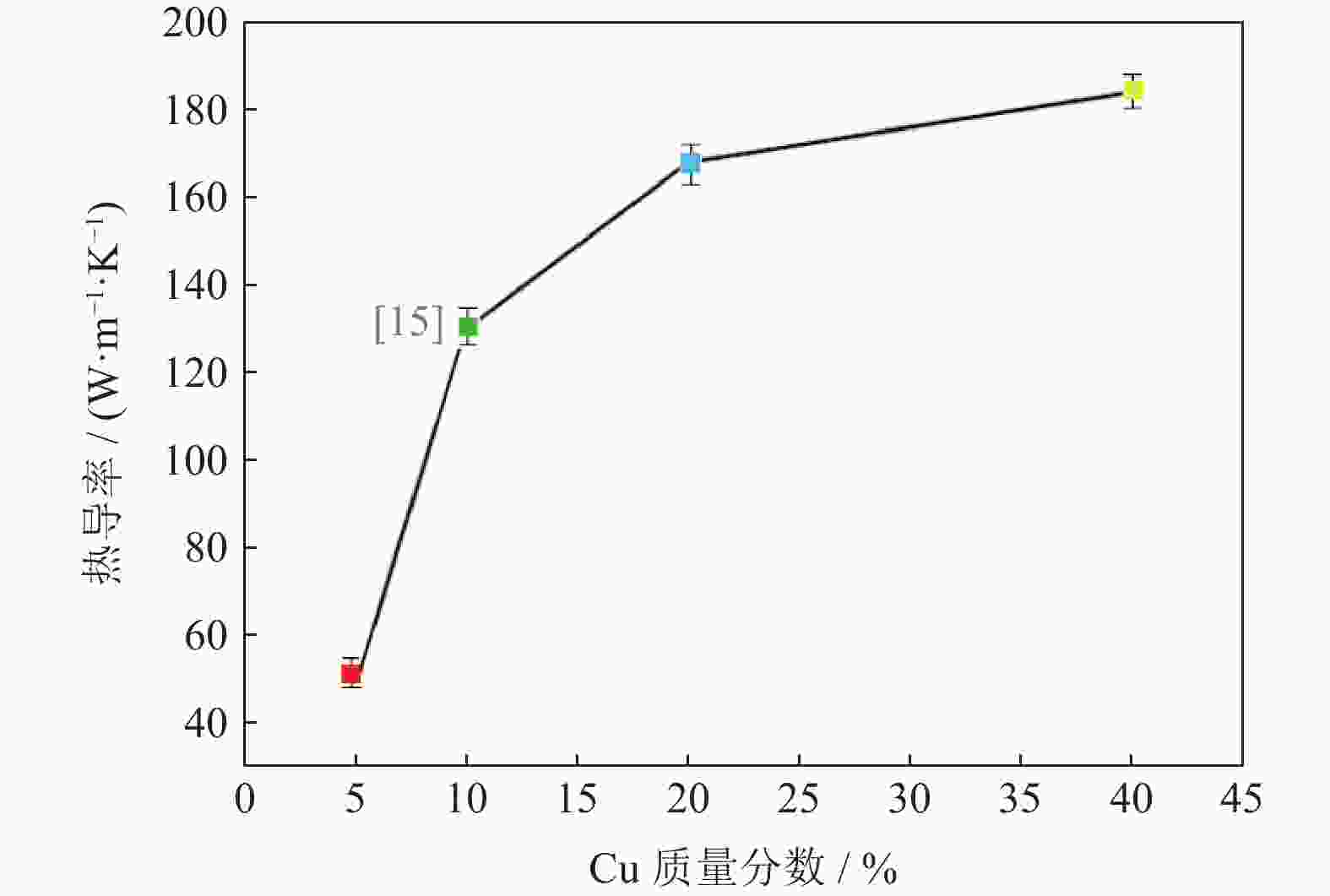Preparation of ultra-fine molybdenum‒copper composite powders and fine-grained molybdenum‒copper alloys
-
摘要: 采用“缺碳预还原+氢气深脱氧”方法制备了不同Cu含量(5%、20%、40%,质量分数)的超细Mo–Cu复合粉末。通过高温煅烧钼酸铵和硝酸铜混合物制备了MoO3和CuO复合氧化物,再利用炭黑预还原脱除煅烧产物(CuMoO4–MoO3)中绝大部分氧的方法制备了含有少量MoO2的超细预还原Mo–Cu复合粉体;少量MoO2的存在可以极大降低预还原产物中碳的残留;最后,经氢还原脱除残留的氧制备得到超细、高纯度Mo–Cu复合粉体,粉体粒度约为200 nm。以Mo–Cu复合粉体为原料,经过压坯和烧结制备得到细晶Mo–Cu合金。结果表明,经过1200 ℃烧结后,随着Cu质量分数由5%增加到20%,合金相对密度由96.3%增加到98.5%,且Mo、Cu两相分布均匀。Mo–Cu合金硬度随Cu含量的增加而先增加后降低,这是由合金相对密度和铜含量对硬度的影响不同所导致的。随着Cu质量分数由5%增加到40%,Mo–Cu合金的热导率由48.5 W·m−1·K−1增加到187.2 W·m−1·K−1,电导率由18.79% IACS增加到49.48% IACS。Abstract: Ultra-fine Mo–Cu composite powders with the different Cu contents (5%, 20%, 40%, mass fraction) were prepared by the method of "carbothermic pre-reduction by insufficient carbon and deep deoxidation by hydrogen". MoO3 and CuO composite oxides were prepared by calcining a mixture of ammonium molybdate and copper nitrate at high temperature, and then most of the oxygen in the calcined products (CuMO4–MoO3) was removed by the carbothermic pre-reduction with carbon black to prepare the pre-reduced Mo–Cu composite powders containing a small amount of MoO2, the existence of which could greatly reduce the residual carbon in the pre-reduction products. Then, the remaining oxygen was removed by hydrogen reduction to prepare the ultra-fine Mo–Cu composite powders with a high purity. The particle size of the prepared ultra-fine Mo–Cu composite powders was about 200 nm. The fine-grained Mo–Cu alloys were directly prepared through the compaction and sintering by using the prepared ultra-fine Mo–Cu composite powders as the raw materials. In the results, the relative density of the fine-grained Mo–Cu alloys increases from 96.3% to 98.5% as the Cu mass fraction increases from 5% to 20% at the sintering temperature of 1200 ℃, and the Mo and Cu phases are homogeneously distributed. The hardness of the Mo–Cu alloys after sintering at 1200 ℃ first increases and then decreases with the increase of the Cu content, since the relative density and copper content have the different influences on the hardness of alloys. Furthermore, with the increase of copper mass fraction from 5% to 40%, the thermal conductivity and electrical conductivity of alloys increase from 48.5 W·m−1·K−1 to 187.2 W·m−1·K−1, and from 18.79% IACS to 49.48% IACS, respectively.
-
Key words:
- Mo–Cu alloys /
- ultra-fine powders /
- relative density /
- hardness /
- thermal conductivity /
- electrical conductivity
-
图 1 Mo–20%Cu不同阶段反应产物的X射线衍射分析:(a)C/MoO3摩尔比1.9和2.0,1050 ℃碳热还原;(b)C/MoO3摩尔比1.9,750 ℃氢还原
Figure 1. XRD patterns of Mo–20%Cu powders obtained at different stages: (a) carbothermal reduction at 1050 ℃ under the C/MoO3 molar ratios of 1.9 and 2.0; (b) hydrogen reduction at 750 ℃ under the C/MoO3 molar ratio of 1.9
图 4 不同Cu质量分数Mo–Cu合金在1150 ℃和1200 ℃烧结后的横截面微观形貌:(a)5%,1150 ℃;(b)5%,1200 ℃;(c)10%[15],1150 ℃;(d)10%[15],1200 ℃;(e)20%,1150 ℃;(f)20%,1200 ℃;(g)40%,1150 ℃;(h)40%,1200 ℃
Figure 4. Cross-section micro-morphology of the Mo–Cu alloys with the different Cu mass fractions after sintering at 1150 ℃ and 1200 ℃: (a) 5%, 1150 ℃; (b) 5%, 1200 ℃; (c) 10%[15], 1150 ℃; (d) 10%[15], 1200 ℃; (e) 20%, 1150 ℃; (f) 20%, 1200 ℃; (g) 40%, 1150 ℃; (h) 40%, 1200 ℃
图 5 不同Cu含量Mo–Cu合金在1150 ℃和1200 ℃烧结后的断口形貌:(a)5%,1150 ℃;(b)5%,1200 ℃;(c)10%[15],1150 ℃;(d)10%[15],1200 ℃;(e)20%,1150 ℃;(f)20%,1200 ℃;(g)40%,1150 ℃;(h)40%,1200 ℃
Figure 5. Fracture morphology of the Mo–Cu alloys with the different Cu mass fractions after sintering at 1150 ℃ and 1200 ℃: (a) 5%, 1150 ℃; (b) 5%, 1200 ℃; (c) 10%[15], 1150 ℃; (d) 10%[15], 1200 ℃; (e) 20%, 1150 ℃; (f) 20%, 1200 ℃; (g) 40%, 1150 ℃; (h) 40%, 1200 ℃
表 1 不同Cu质量分数Mo–Cu复合粉末的残余碳含量(质量分数)
Table 1. Residual carbon mass fraction of Mo–Cu composite powders with the different Cu mass fractions
Cu质量分数 / % C质量分数 / % 5 0.026 20 0.023 40 0.021 表 2 不同Cu含量Mo–Cu复合粉末的平均晶粒尺寸
Table 2. Average grain size of the Mo–Cu composite powders with the different Cu mass fractions
Cu质量分数 / % 温度 / ℃ 晶粒尺寸 / nm 5 1050 52 750 81 10 1050 73 750 102 20 1050 96 750 153 40 1050 175 750 236 表 3 不同Cu含量的Mo–Cu合金在1150 ℃和1200 ℃烧结后的相对密度
Table 3. Relative densities of the Mo–Cu alloys with the different Cu mass fractions after sintering at 1150 ℃ and 1200 ℃
Cu质量分数 / % 烧结温度 / ℃ 相对密度 / % 5 1150 94.8 1200 96.3 20 1150 96.0 1200 98.5 40 1150 95.2 1200 97.9 表 4 不同Cu含量的Mo–Cu合金在1150 ℃和1200 ℃烧结后的收缩率
Table 4. Shrinkage of the Mo–Cu alloys with the different Cu mass fractions after sintering at 1150 ℃ and 1200 ℃
合金 烧结温度 / ℃ 径向收缩率 / % 轴向收缩率 / % Mo–5Cu 1150 13.8 13.5 1200 15.1 14.9 Mo–20Cu 1150 15.1 14.4 1200 16.2 15.5 Mo–40Cu 1150 14.9 14.1 1200 15.8 15.3 表 5 不同Cu含量Mo–Cu合金中钼颗粒在1150 ℃和1200 ℃烧结后的平均晶粒尺寸
Table 5. Average grain size of the Mo–Cu alloys with different Cu mass fractions after sintering at 1150 ℃ and 1200 ℃
Cu质量分数 / % 烧结温度 / ℃ 平均晶粒尺寸 / μm 5 1150 1.8 1200 1.9 20 1150 1.5 1200 2.3 40 1150 2.1 1200 1.7 -
[1] Ali Z A, Drury O B, Cunningham M F, et al. Fabrication of Mo/Cu multilayer and bilayer transition edge sensors. IEEE Trans Appl Supercond, 2005, 15(2): 526 doi: 10.1109/TASC.2005.849897 [2] Sun A, Wang D, Wu Z, et al. Synthesis of ultra-fine Mo–Cu nanocomposites by coreduction of mechanical-activated CuMoO4–MoO3 mixtures at low temperature. J Alloys Compd, 2010, 505(2): 588 doi: 10.1016/j.jallcom.2010.06.080 [3] Johnson J L, German R M. Powder metallurgy processing of Mo–Cu for thermal management applications. Int J Powder Metall, 1999, 35(8): 39 [4] Yao J T, Li C J, Li Y, et al. Relationships between the properties and microstructure of Mo–Cu composites prepared by infiltrating copper into flame-sprayed porous Mo skeleton. Mater Des, 2015, 88: 774 doi: 10.1016/j.matdes.2015.09.062 [5] Wang D, Dong X, Zhou P, et al. The sintering behavior of ultra-fine Mo–Cu composite powders and the sintering properties of the composite compacts. Int J Refract Met Hard Mater, 2014, 42: 240 doi: 10.1016/j.ijrmhm.2013.09.012 [6] Chwa S O, Klein D, Liao H, et al. Temperature dependence of microstructure and hardness of vacuum plasma sprayed Cu–Mo composite coatings. Surf Coat Technol, 2006, 200(20): 5682 [7] Belay O V, Kiselev S P. Molecular dynamics simulation of deformation and fracture of a “copper-molybdenum” nanocomposite plate under uniaxial tension. Phys Mesomech, 2011, 14(3): 145 [8] Wahl K J, Seitzman L E, Bolster R N, et al. Ion-beam deposited Cu–Mo coatings as high temperature solid lubricants. Surf Coat Technol, 1997, 89(3): 245 doi: 10.1016/S0257-8972(96)02900-3 [9] Jiang Z W. Study on Electroless Cu Plating of Mo Powders and Sintering Process[Dissertation]. Zhengzhou: Zhengzhou University, 2015姜智文. 化学镀制备Mo–20Cu复合粉末及坯体烧结性能的研究[学位论文]. 郑州: 郑州大学, 2015 [10] Song P, Cheng J, Wan L, et al. Preparation and characterization of Mo–15Cu superfine powders by a gelatification-reduction process. J Alloys Compd, 2009, 476(1): 226 [11] Chen Y B, Fan J L, Liu T, et al. Fabrication of fine-grained Mo–Cu alloy. Chin J Nonferrous Met, 2008, 18(6): 1039 doi: 10.3321/j.issn:1004-0609.2008.06.014陈玉柏, 范景莲, 刘涛, 等. 细晶钼铜合金的制备. 中国有色金属学报, 2008, 18(6): 1039 doi: 10.3321/j.issn:1004-0609.2008.06.014 [12] Sun G D, Wang K F, Song C M, et al. A low-cost, efficient, and industrially feasible pathway for large scale preparation of tungsten nanopowders. Int J Refract Met Hard Mater, 2019, 78: 100 doi: 10.1016/j.ijrmhm.2018.08.013 [13] Sun G D, Zhang G H. Novel pathway to prepare Mo nanopowder via hydrogen reduction of MoO2 containing Mo nanoseeds produced by reducing MoO3 with carbon black. JOM, 2020, 72: 347 doi: 10.1007/s11837-019-03445-4 [14] Wang D H, Sun G D, Zhang G H. Preparation of ultrafine Mo powders via carbothermic pre-reduction of molybdenum oxide and deep reduction by hydrogen. Int J Refract Met Hard Mater, 2018, 75: 70 doi: 10.1016/j.ijrmhm.2018.04.002 [15] Ji X P, Cao W C, Bu C Y, et al. A new route for preparing Mo–10wt.%Cu composite compacts. Int J Refract Met Hard Mater, 2019, 81: 196 doi: 10.1016/j.ijrmhm.2019.03.008 [16] Utigard T. Oxidation mechanism of molybdenite concentrate. Metall Mater Trans B, 2009, 40(4): 490 doi: 10.1007/s11663-009-9245-z [17] Deevi S C. Self-propagating high-temperature synthesis of molybdenum disilicide. J Mater Sci, 1991, 26(12): 3343 doi: 10.1007/BF01124683 [18] Schulmeyer W V, Ortner H M. Mechanisms of the hydrogen reduction of molybdenum oxides. Int J Refract Met Hard Mater, 2002, 20(4): 261 doi: 10.1016/S0263-4368(02)00029-X [19] Enneti R K. Rate control mechanism for the hydrogen reduction of MoO3 to MoO2. Int J Refract Met Hard Mater, 2012, 33: 122 doi: 10.1016/j.ijrmhm.2012.03.006 [20] Dang J, Zhang G H, Wang L, et al. Study on hydrogen reduction of Mo4O11. Int J Refract Met Hard Mater, 2015, 51: 275 doi: 10.1016/j.ijrmhm.2015.05.001 [21] Ressler T, Jentoft R E, Wienold J, et al. In situ XAS and XRD studies on the formation of Mo suboxides during reduction of MoO3. J Phys Chem B, 2000, 104(27): 6360 doi: 10.1021/jp000690t [22] Majumdar S, Sharma I G, Samajdar I, et al. Kinetic studies on hydrogen reduction of MoO3 and morphological analysis of reduced Mo powder. Metall Mater Trans B, 2008, 39: 431 doi: 10.1007/s11663-008-9152-8 [23] Ren S X, Chen W G, Feng T, et al. Microstructure and properties of carbon fiber reinforced Fe–Cu based friction materials prepared by powder metallurgy. Powder Metall Technol, 2020, 38(2): 104任澍忻, 陈文革, 冯涛, 等. 粉末冶金制备碳纤维增强铁–铜基摩擦材料的组织与性能. 粉末冶金技术, 2020, 38(2): 104 [24] Lu B, Zhu J F, Fang Y, et al. Effect of SiC on the microstructure and mechanical properties of aluminum matrix composites by in-situ synthesis. Powder Metall Technol, 2020, 38(1): 42卢博, 朱建锋, 方媛, 等. 原位合成SiC对铝基复合材料微观组织和力学性能的影响. 粉末冶金技术, 2020, 38(1): 42 [25] Wang D F, Ma B, Ma L C, et al. Effect of WC grain size on the microstructure and mechanical properties of HVOF-sprayed WC–10Co4Cr coatings. Powder Metall Technol, 2019, 37(6): 434王大锋, 马冰, 马良超, 等. WC颗粒尺寸对超音速火焰喷涂WC–10Co4Cr涂层组织及力学性能的影响. 粉末冶金技术, 2019, 37(6): 434 [26] Kim D G, Kim G S, Oh S T, et al. The initial stage of sintering for the W–Cu nanocomposite powder prepared from W–CuO mixture. Mater Lett, 2004, 58(5): 578 doi: 10.1016/j.matlet.2003.07.044 -




 下载:
下载:
